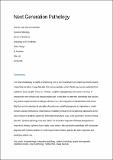Files in this item
Next-generation pathology
Item metadata
| dc.contributor.author | Caie, Peter D | |
| dc.contributor.author | Harrison, David J | |
| dc.contributor.editor | Schmitz, Ulf | |
| dc.contributor.editor | Wolkenhauer, Olaf | |
| dc.date.accessioned | 2017-01-02T00:33:04Z | |
| dc.date.available | 2017-01-02T00:33:04Z | |
| dc.date.issued | 2016 | |
| dc.identifier | 240275801 | |
| dc.identifier | 4d785115-f346-4b04-a973-4e643d781cf8 | |
| dc.identifier | 26677179 | |
| dc.identifier | 84950238992 | |
| dc.identifier | 000368813900005 | |
| dc.identifier.citation | Caie , P D & Harrison , D J 2016 , Next-generation pathology . in U Schmitz & O Wolkenhauer (eds) , Systems Medicine . Methods in Molecular Biology , vol. 1386 , Humana Press , pp. 61-72 . https://doi.org/10.1007/978-1-4939-3283-2_4 | en |
| dc.identifier.isbn | 9781493932825 | |
| dc.identifier.isbn | 9781493932832 | |
| dc.identifier.other | ORCID: /0000-0002-0031-9850/work/60196552 | |
| dc.identifier.other | ORCID: /0000-0001-9041-9988/work/64034291 | |
| dc.identifier.uri | https://hdl.handle.net/10023/10033 | |
| dc.description.abstract | The field of pathology is rapidly transforming from a semiquantitative and empirical science toward a big data discipline. Large data sets from across multiple omics fields may now be extracted from a patient's tissue sample. Tissue is, however, complex, heterogeneous, and prone to artifact. A reductionist view of tissue and disease progression, which does not take this complexity into account, may lead to single biomarkers failing in clinical trials. The integration of standardized multi-omics big data and the retention of valuable information on spatial heterogeneity are imperative to model complex disease mechanisms. Mathematical modeling through systems pathology approaches is the ideal medium to distill the significant information from these large, multi-parametric, and hierarchical data sets. Systems pathology may also predict the dynamical response of disease progression or response to therapy regimens from a static tissue sample. Next-generation pathology will incorporate big data with systems medicine in order to personalize clinical practice for both prognostic and predictive patient care. | |
| dc.format.extent | 12 | |
| dc.format.extent | 105791 | |
| dc.language.iso | eng | |
| dc.publisher | Humana Press | |
| dc.relation.ispartof | Systems Medicine | en |
| dc.relation.ispartofseries | Methods in Molecular Biology | en |
| dc.subject | Histopathology | en |
| dc.subject | Integrative pathology | en |
| dc.subject | Systems pathology | en |
| dc.subject | Spatial heterogeneity | en |
| dc.subject | Predictive models | en |
| dc.subject | Cancer pathology | en |
| dc.subject | Multi-omics | en |
| dc.subject | Image analysis | en |
| dc.subject | RB Pathology | en |
| dc.subject | RC0254 Neoplasms. Tumors. Oncology (including Cancer) | en |
| dc.subject | SDG 3 - Good Health and Well-being | en |
| dc.subject.lcc | RB | en |
| dc.subject.lcc | RC0254 | en |
| dc.title | Next-generation pathology | en |
| dc.type | Book item | en |
| dc.contributor.institution | University of St Andrews. School of Medicine | en |
| dc.identifier.doi | 10.1007/978-1-4939-3283-2_4 | |
| dc.date.embargoedUntil | 2017-01-01 |
This item appears in the following Collection(s)
Items in the St Andrews Research Repository are protected by copyright, with all rights reserved, unless otherwise indicated.

